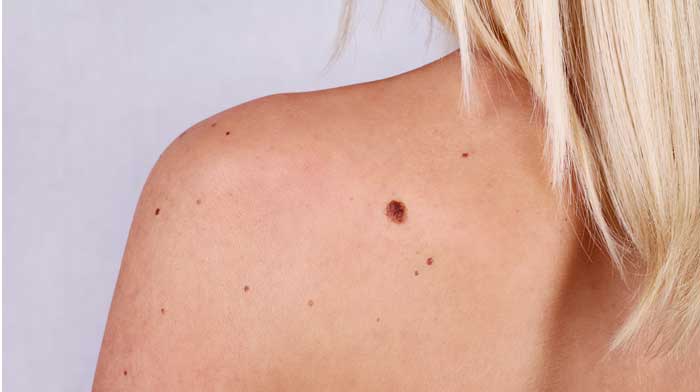
Moles
A mole is a harmless collection of pigment cells (called melanocytes) in the skin. These pigment cells are found throughout the skin, but are are crowded together in moles. The medical term for a mole is a benign melanocytic naevus (pronounced ‘nee-vus’). Some moles are completely flat and dark (called a junctional naevus) some are slightly raised and brown (called a compound naevus) and some are fleshy and the same colour as the rest of the skin (called an intradermal naevus).
At what age do moles develop?
Most moles are not present at birth, but develop from about the 2nd year of life onwards until middle age. About one in a hundred babies is born with a pigmented mole birthmark (called a congenital melanocytic naevus). Adults can develop new moles in their 30s and 40s but if they notice a new mole should keep a very close eye on it to check it doesn’t develop any warning signs of skin cancer.
I’ve noticed a mole that is changing. What should I do?
Remember that moles normally change slowly as people get older, generally becoming paler and more raised with time. Many women notice that their moles change during pregnancy. This is normal. However it is wise to be extremely cautious if you notice new mole or a mole that is changing, because rarely it may be a sign of malignant melanoma, a serious form of skin cancer. The golden rule is
‘If in doubt, get the mole checked out’
If you are concerned about a mole you should see your GP who can refer you to an NHS or private dermatologist.
How should I keep an eye on my moles?
In the same way that women and men are encouraged to perform self examination to detect breast and testicular cancers, it is very worthwhile keeping a regular eye on your skin and developing a mental picture of your moles, so you are able to tell if one has changed. Skin cancer is unique because unlike any other cancer, when it is at its early stage it is visible on the outside of the body, which gives a good opportunity for complete cure. Once skin cancer has spread internally, treatment is much more difficult. A good idea is to obtain a full length mirror and to examine yourself without clothes every 3-4 months. A partner may be able to help keep an eye on moles on your back.
What are the warning signs of malignant melanoma?
If you notice one or more of the following you should arrange to see a doctor:
A new or existing mole that is changing SIZE
A new or existing mole that is changing SHAPE
A new or existing mole that is changing COLOUR
Melanomas sometimes also ITCH or BLEED.
Only about half of melanomas come from a pre-existing mole. The rest occur in normal skin.
Remember that all these changes can occur in completely normal moles as well.






